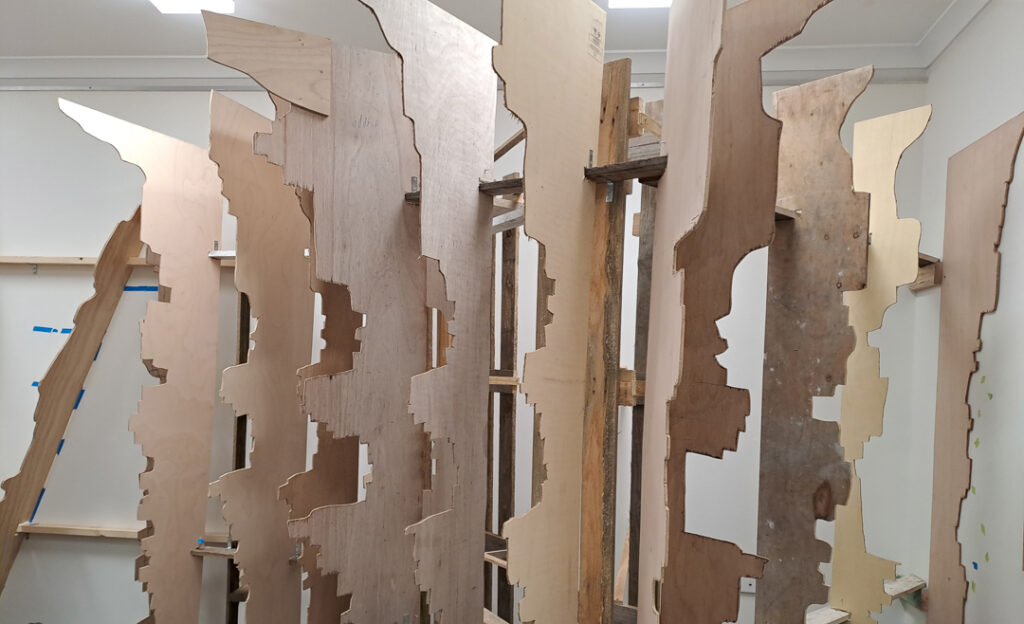
Where to place a grotto? Structural grotto (exchange) 2024 by Perdita Phillips. Location: Mundaring Arts Centre as part of the Mélange exhibition as part of IOTA24. Installation with recycled timber and pallets, ply, cardboard, sound tracks.
Our August laurel goes to Perdita Phillips for a cardboard grotto that beautifully frames an exhibition of geological finds.
My art process mostly begins in spaces where more-than-human others dominate and survive: rural and remote, or pockets of nature in urban areas. It springs from walking and listening and includes ephemeral interactions and ‘micro-events’ in those places. Attentiveness to the ecological and cultural patterns of place is important. When faced with creating works for human-made interior spaces, the differences (and requisite transformations) between ‘here’ and ‘there’ are an ongoing fascination. How do you communicate other forces, other temporal senses, other matters?
The organic growth of professional friendships over the last thirty years germinated from shared artistic and philosophical interests. Recently I have been lucky to have interacted with artists such as the underFOOT group. We shared meals and conversations on our retreats at Broke Inlet (southwest WA) and as part of projects, residencies and protests (at Roe 8).
For the Mélange show, I wanted to create a space to convey the comfort and inspiration of sharing time. We planned not-so-round table events to accompany the exhibition and I proposed creating a space that would envelop the participants and audiences in an installation in gallery 2 of the Mundaring Arts Centre—working with the emotional register of coming together to listen and talk.
Cardboard is a lo-fi material, and, along with recycled pallets and ply, forms the main ingredients of the structural grotto (exchange). Riffing off grotto follies from garden history, the process was a careful investigation of geoaesthetics, but also sits within the realm of a model: a cardboard-coloured approximation of ‘there’. The pallets were gathered from industrial areas and assembled at the Women On The Tools workshop in Beaconsfield (WA). The work was then made in the gallery as part of the underFOOT artist in residence: a cardboard and paper maquette was generated based on a close study of rocks I had collected. The ply profiles were designed on paper and adjusted on-the-spot as I held the stones in my hands. Hand tools were used for cutting, fastening and glueing. There was a constant play in the construction between intentions and outcomes: cardboard as a willing and unwilling participant. Potentials were planned but then altered in situ in response to the materiality of making.
- Perdita Phillips in the studio; photo: Annette Nykiel
- Perdita Phillips structural grotto exchange detail of construction showing recycled timber and ply; photo: Annette Nkiel
Created in a gallery, the installation was nevertheless conceived as deeply connected to places. It’s a summation of rockiness—an analogue compendium of responding to fractures, weathering and erosion. The grotto contains aspects of massive blocky Kimberley sandstones (where I did my PhD) and banded iron formations of Karinjini (lands of the Banyjima, Innawonga and Kurrama people) that I first visited as a child—and that granular sense of coastal limestones cliffs of the Swan Coastal Plain and their fresh, faintly pinkish, fleshy underhangs.
The Arts Centre sits on the Yilgarn Plateau on unceded Whadjuk Noongar land. In geology, a mélange consists of fragments of rocks within a deformed sedimentary matrix (up to kilometre-scale). A mélange can come into existence during tectonic convergence that forms mountain belts, the roots of which can still be discerned in the deeply weathered and eroded Plateau. A sense of deeper time is present in the installation’s two soundtracks that play underground groans and ‘knockers’.
One of the key documents in the exhibition is a found map: an aged print of a Landsat image from 1976. It clearly shows the Darling Fault and the pinkish tones of the Jarrah forest against the straw-coloured background. You can see a similar fault structure in the structural grotto (exchange). Crossing different scales, the grotto and the accompanying Terrane Tables might be caves, cliffs, geological melanges or tiny breccia samples.
Perdita Phillips lives near Dwertawirrinup on unceded Wadjak Nyoongar boodja. Visit www.perditaphillips.com/ and follow @perditaphillips





